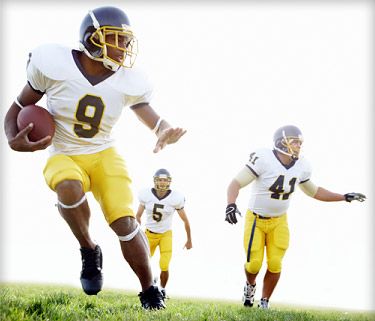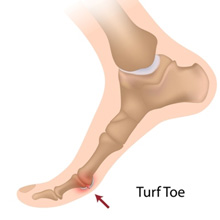Sports Injuries
Turf Toe
Turf Toe:
Symptoms, Causes, and Treatments
Turf toe is not a term you want to use when talking to a head football coach about his star running back or the ballerina before her diva debut. “Turf toe” is the common term used to describe a sprain of the ligaments around the big toe joint. Although it’s commonly associated with football players who play on artificial turf, it affects athletes in other sports including soccer, basketball, wrestling, gymnastics, and dance. It’s a condition that’s caused by jamming the big toe or repeatedly pushing off the big toe forcefully as in running and jumping.
Here is information about turf toe — what causes it, how to prevent it, and how it’s treated — to help you stay in the game.

What Causes Turf Toe?
Turf toe is a sprain to the ligaments around the big toe joint, which works primarily as a hinge to permit up and down motion. Just behind the big toe joint in the ball of your foot are two pea-shaped bones embedded in the tendon that moves your big toe called sesamoids. These bones work like a pulley for the tendon and provide leverage when you walk or run. They also absorb the weight that presses on the ball of the foot.
When you are walking or running, you start each subsequent step by raising your heel and letting your body weight come forward onto the ball of your foot. At a certain point you propel yourself forward by “pushing off” of your big toe and allowing your weight to shift to the other foot. If the toe for some reason stays flat on the ground and doesn’t lift to push off, you run the risk of suddenly injuring the area around the joint. Or if you are tackled or fall forward and the toe stays flat, the effect is the same as if you were sitting and bending your big toe back by hand beyond its normal limit, causing hyperextension of the toe. That hyperextension, repeated over time or with enough sudden force, can — cause a sprain in the ligaments that surround the joint.
Typically with turf toe, the injury is sudden. It is most commonly seen in athletes playing on artificial surfaces, which are harder than grass surfaces and to which cleats are more likely to stick. It can also happen on a grass surface, especially if the shoe being worn doesn’t provide adequate support for the foot. Often the injury occurs in athletes wearing flexible soccer-style shoes that let the foot bend too far forward.
What Are the Symptoms of Turf Toe?
The most common symptoms of turf toe include pain, swelling, and limited joint movement at the base of one big toe. The symptoms develop slowly and gradually get worse over time if it’s caused by repetitive injury. If it’s caused by a sudden forceful motion, the injury can be painful immediately and worsen within 24 hours. Sometimes when the injury occurs, a “pop” can be felt. Usually the entire joint is involved, and toe movement is limited.
How Is Turf Toe Diagnosed?
To diagnose turf toe, the doctor will ask you to explain as much as you can about how you injured your foot and may ask you about your occupation, your participation in sports, the type of shoes you wear, and your history of foot problems. The doctor will then examine your foot, noting the pattern and location of any swelling and comparing the injured foot to the uninjured one. The doctor will likely ask for an X-ray to rule out any other damage or fracture. In certain circumstances, the doctor may ask for other imaging tests such as a bone scan, CT scan, or MRI.
The diagnosis will then be made based on the results of the physical examination and imaging tests.
How Is Turf Toe Treated?
The basic treatment for treating turf toe, initially, is a combination of rest, ice, compression, and elevation (remember the acronym R.I.C.E).This basic treatment approach is to give the injury ample time to heal, which means the foot will need to be rested and the joint protected from further injury. The doctor may recommend an over-the-counter oral medication such as ibuprofen to control pain and reduce inflammation. To rest the toe, the doctor may tape or strap it to the toe next to it to relieve the stress on it. Another way to protect the joint is to immobilize the foot in a cast or special walking boot that keeps it from moving. The doctor may also ask you to use crutches so that no weight is placed on the injured joint. In severe cases, an orthopaedic surgeon may suggest a surgical intervention.
It typically takes two to three weeks for the pain to subside. After the immobilization of the joint ends, some patients require physical therapy in order to re-establish range of motion, strength, and conditioning of the injured toe.
Can Turf Toe Be Prevented?
One goal of treatment should be to evaluate why the injury occurred and to take steps to keep it from reoccurring.
One way to prevent turf toe is to wear shoes with better support to help keep the toe joint from excessive bending and force with pushing off. You may also want to consider using specially designed inserts that your doctor or physical therapist can prescribe for you.
A physical therapist or a specialist in sports medicine can also work with you on correcting any problems in your gait that can lead to injury and on developing training techniques to help reduce the chance of injury.

